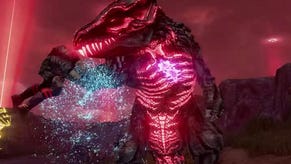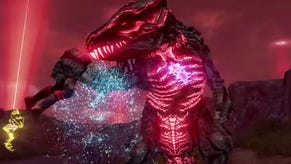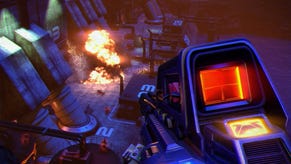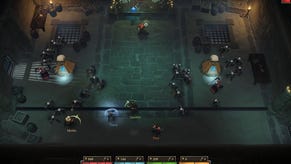Face-Off: Far Cry 3: Blood Dragon
Scale models.
| - | Xbox 360 | PlayStation 3 | PC |
|---|---|---|---|
| Install | 1.4GB | 1.9GB | 3.2GB |
| Surround Support | Dolby Digital | Dolby Digital, DTS, 5.1LPCM | Set-up dependant |
Far Cry 3: Blood Dragon will go down as one of the strangest Face-Off subjects we've covered in recent times. On the one hand, the game is built on what ranks among the industry's finest multi-platform engines, Ubisoft Montreal's own Dunia Engine 2, which specialises in realising sprawling sandbox environments subject to wild-fire outbursts and dynamic weather.
However, unlike its use in last year's Far Cry 3, this stand-alone expansion avoids playing to the technology's usual strengths. Rather, it hampers its visuals outright to stick to a garish retro 80s aesthetic. It shrouds the details of its world in an overbearing smog, forces blood-red scan-lines over the picture, and bears out its coming-of-machismo story mostly through pixellated 2D cut-scenes. And yet, for all that, bizarrely, it works.
The humour in this small-scale release is crucially at centre-stage - a nutty satire, which for some will call to mind the deranged pulp schlock of Garth Marenghi's Darkplace. The basic template of Far Cry 3's gameplay remains largely as-is, with hunting animals and securing territories serving as asides to the main adventure, but it's the visual design that receives the biggest overhaul. The switch-up is taken to an absolute extreme: details in game's bleak wastelands are now punctuated by sharp bursts of fluorescent pink and green - a simple look that's far removed from the lush jungles we explored in the previous game.
On the surface it's unrecognisable as a Far Cry game, but a close look at the PS3, 360 and PC versions of Blood Dragon reveals a familiar technical origin. To see how each edition compares, and to establish whether any engine optimisations have been made since Far Cry 3's launch just five months ago, we pit each format against the other in our head-to-head videos. Meanwhile, for those keen to inspect the finer details in static form we also offer our 30-strong triple format comparison gallery.
"Blood Dragon isn't anywhere near as visually lush as standard Far Cry 3, with much of the detail hidden beneath the post-processing and the retro-style scan-lines."
Alternative comparisons:
Given the near-parity among the console versions of Far Cry 3, we're unlikely to see any radical shifts in the make-up of each version. Sure enough, as far as resolution goes we're getting the same deal as before; rather than upscaling a sub-720p image to produce a slightly fuzzy interpolated image, both platforms maintain sharp outputs by simply stripping away pixels around the edges. On the 360, this results in eight-pixel high borders to the top and bottom of the image, giving us an effective resolution of 1280x704. For the PS3 version, nine are stripped from the top and bottom, and three to either side, giving us 1274x702 - though in neither case is this easily perceptible, the nipping and tucking disappearing into overscan.
Aliasing is Blood Dragon's biggest issue. The new art direction means we have a constant contrast between the sullen backdrops, and the day-glo colours that line the game's laser-fire, ammo vendors and titular dragons. Stair-stepping artifacts greatly detract from the look of the world in spots, and there's a noticeable lack of any post-processing anti-aliasing to solve this. Even relatively inexpensive methods such as Timothy Lotts' fast-approximate AA could have gone a long way to soften the blow here, but instead, it appears the in-house solution seen in Ubisoft Montreal's last game is either absent, or ineffective against sharp edges in this form. Fortunately for PS3 owners, the inferior dithered shadows seen in the last game aren't in evidence this time. This owes a lot to the lack of strong directional lights while outdoors, plus the scarcity of cut-scenes to draw attention to the effect on character faces; shadows are mostly muted in this world, making both consoles identical in this arena. Meanwhile, the PS3's major advantage in Far Cry 3 - the superior texture filtering - is also nigh on impossible to distinguish from the dark, heavily scan-lined environments of Blood Dragon, which nullifies this advantage as well.
The 360 and PS3 versions still boast a strong screen-space ambient occlusion (SSAO) effect, which adds an extra layer of shading to the environment. The result is a faint shadow to corners of geometry, beneath foliage, and also a dark hue around Rex's gun when pressed against walls. Simulating the way light struggles to reach isolated parts of the world helps to illustrate a sense of depth across surfaces - though the accuracy of this approach pales next to the horizon-based alternative available on PC, which makes the halo effect around the player more subtle.
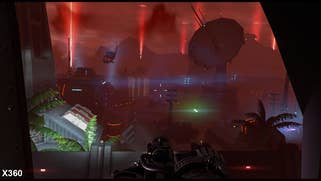
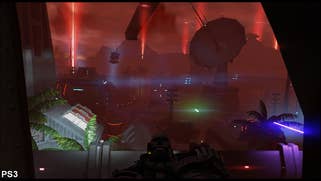
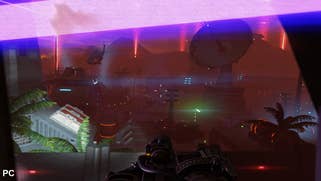

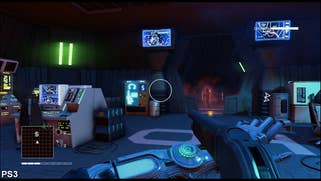
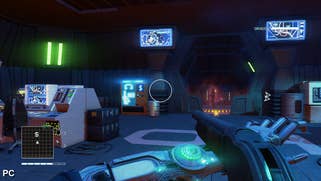

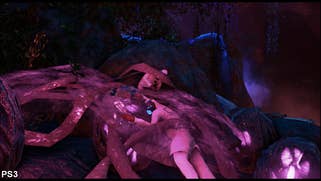

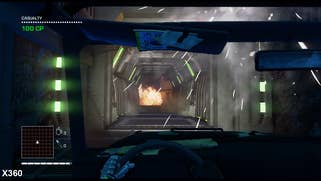
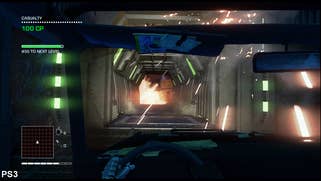

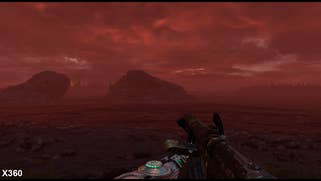
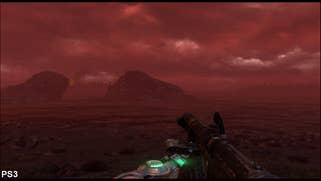
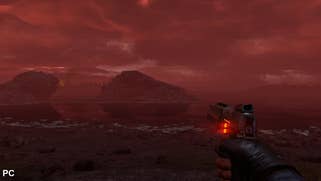
To draw attention to the game's new slate of sci-fi wildlife, every animal has been given a full robotic make-over. A metal shader layer runs over the top of the creatures, giving us bizarre, augmented alternatives like cyber sharks and robo dogs. Rex's chrome arms show the shader off too as he delivers his many reload animations. That said, character models themselves are rarely given any form of close-up, due to the preference towards 16-bit style animations for cut-scenes. The world is less appealing to look at - though deliberately so - with a reliance on a heavy red fog effect to disguise the game's draw distances effectively.
As far as terrain detail goes, there is very little to tell the three versions apart. The high world detail setting on PC allows for a greater density of trees, though the game is still relatively barren in this sense compared to Far Cry 3's flourishes. Triangle culling is also used more aggressively on PS3 and 360 - a level-of-detail (LOD) scaling technique that dynamically alters the quality of geometry based on Rex's distance to certain objects. From a performance perspective, this is an excellent cost-saving trick that doesn't affect the appearance of larger building blocks, such as garrison structures or the blood dragons. Instead, it's only noticeable on minor items like crates, and even then their shapes are filled out fully again within a blink of an eye.
But is there anything noticeably pared back on the console versions? While it's impressive the PS3 and 360 releases share so much of the content seen on PC, the Steam version's larger 3.2GB install does account for the option to choose much higher-resolution textures. It isn't brought into the spotlight often due to the permanent night-time setting, but the boost in detail is still appreciated, and also covers the game's many effects. Specifically, the PC offers crisp alpha effects for flame-thrower sprays and blood splatters, whereas the consoles put out blurrier, low fidelity buffers for each. Full-screen motion blur is a welcome bonus too, though perhaps the greatest respite in playing the PC edition comes from the ability to turn MSAA on, which effectively cuts down the glaring stair-stepping we see on the game's many straight neon lines.
Of course, the inherent advantage of the PC version is that many of these subtle detail boosts can be appreciated through a finer, higher resolution window. Curiously, by default the PC version uses a narrower field-of-view (FOV) value than consoles: it starts at 73.15, whereas other releases are set to the equivalent of 78.65. This can be tweaked easily through a simple drag of a slider, though it does bear mention when considering the slight stretching to our PC shots.
"PC offers the best visual presentation thanks to the inclusion of full-on anti-aliasing plus support for higher resolutions and smoother frame-rates."
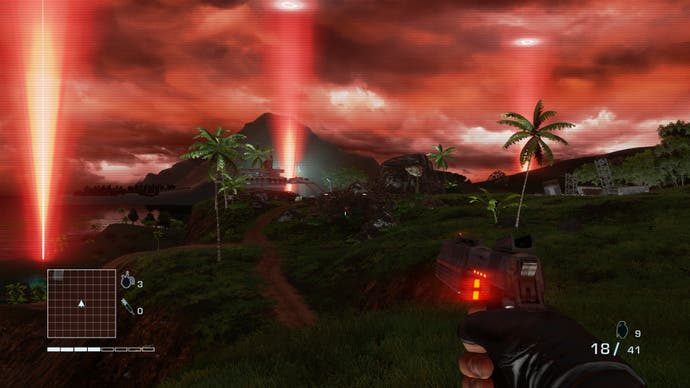
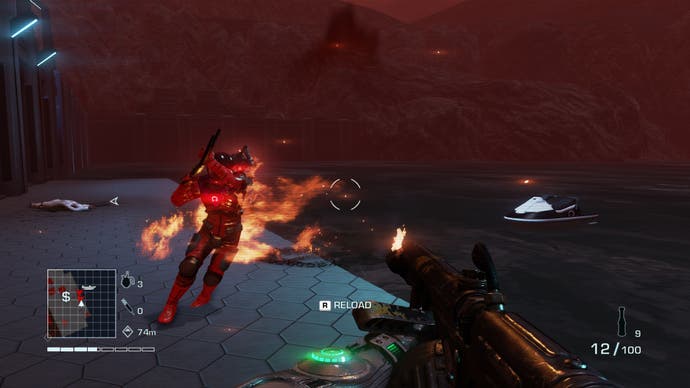


Far Cry 3: Blood Dragon - performance analysis
With image quality tests being very close indeed between the two consoles, it's time to move on to frame-rate analysis. With cut-scenes being few and far between this time, and the world's draw distances hidden by a fog-like haze, there's every reason to expect a minor advance in performance over Far Cry 3. Here we put both gameplay and in-engine cut-scenes to the test, with the hopes that the full-screen tearing and frame-rate dips of last game have been alleviated.
From the get-go it doesn't look good. Grabbing a machine gun and letting rip on top of a dam gives us a clear sign of where we're headed. Both the PS3 and 360 suffer from permanent tear-lines which streak down the screen in constant waves during shoot-outs, while the frame-rate hits as low as 22FPS on each platform. This isn't isolated to battles either, and even driving around the wastelands produces similarly choppy results, with the frame-rate sustained at that level.
Neither version engages v-sync, and the slice that appears across each frame proves easier to notice in Blood Dragon given its favour for bright neon lines against dark backgrounds. This could go unnoticed in sections of Far Cry 3, where any tearing at least blends in with its green jungle sprawl, but less so here. The frame-rate dives down to comparable levels - a disappointment considering the environments are less richly detailed on the surface, and how little of the texture-work is actually perceptible.
Assessing the PC version's performance is a much more straight-forward matter, with a toggle available to remove tearing entirely. For an experiment, we play the game at 1080p on our budget-orientated GTX 650 Ti Boost, as reviewed last week in a Core i5 machine over-clocked to 4.2GHz, fitted alongside 8GB of DDR3 RAM.
After some tweaking, post effects and MSAA appear to be the big stumbling blocks for this card when shooting for 60FPS. Once these settings are lowered to medium or removed outright, respectively, it's possible to have all other settings on high without so much as a hiccup. For a higher-end GPU like the GTX 670, this game is a doddle at the ultra preset, where you can also afford to throw in DirectX 11 exclusive features such as 4x MSAA, enhanced alpha-to-coverage, and the more accurate horizon-based ambient occlusion. Those familiar with Far Cry 3 on PC will already have a clear idea of what to expect from their setup when buying this expansion - at its core the demands are identical.
"The Dunia 2 engine is a strange choice for a fairly simple-looking game. It's not as detailed as Far Cry 3, yet the same sub-par performance is evident on both PS3 and Xbox 360."
Far Cry 3: Blood Dragon - the Digital Foundry verdict
All in all, this stand-alone expansion draws on Far Cry 3's strengths in core gameplay design, while its re-jigged cyberpunk aesthetic gives the Dunia Engine 2 a completely different kind of workout. However, Ubisoft Montreal's commitment to recreating the tone of pulp 80s action movies takes precedence over any attempt to truly one-up the last game in the visual stakes. Image quality is actively reduced in fact, with a faux-VHS tracking "snow" effect, aggressive scan-lines, and with the addition of bold neon outlines across its oppressive, dark landscapes. It's unique to the realm of shooters, but we suspect similar results could have been achieved with a less demanding engine.
Compared to Far Cry 3's striking jungle playground, this is really about as close to a polar opposite as you can get. It plays out in the spirit of a mod, featuring an accordingly smaller-scale map, and re-appropriated assets, such as chrome shaded versions of existing animals. Sadly, performance isn't a strong suit with sustained drops to 22FPS being common-place on both consoles, and tearing also consistently afflicting the entire screen during play.
We had hoped the focused visual style in Blood Dragon would lighten the burden on these platforms, but alas it's the same raw deal as the original Far Cry 3. Both PS3 and 360 deliver closer results in terms of image quality than before - discrepancies in resolution aside - while Microsoft's platform offers a minor advantage in frame-rate when strained. Sadly, aliasing is also now an issue due to the abundance of high-contrast lines around this new futuristic setting. This is where the PC version's MSAA saves the day, alongside its provision of motion blur, sharper explosion effects and improved textures. However, if it boils down to a toss-up between the two console releases, you're primed for an equally serviceable retro blast regardless of which version you choose.







